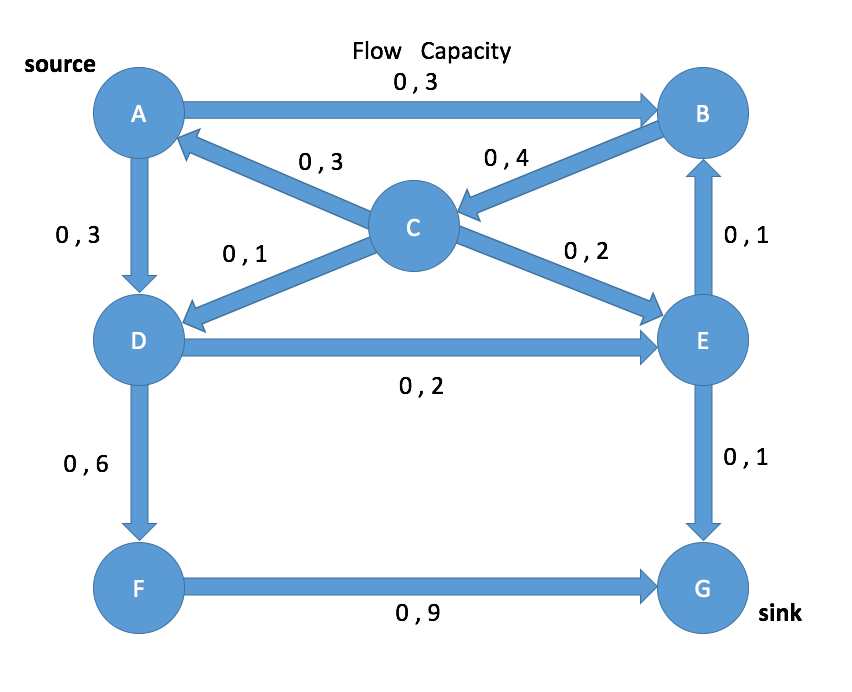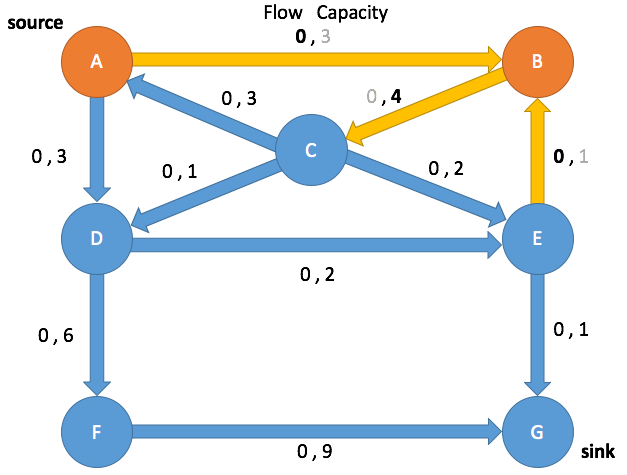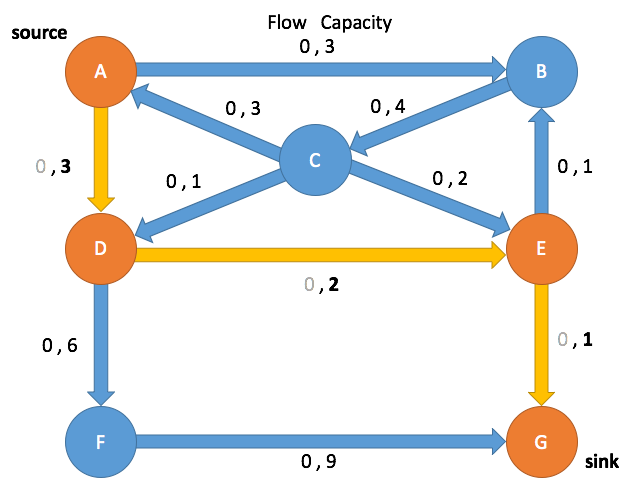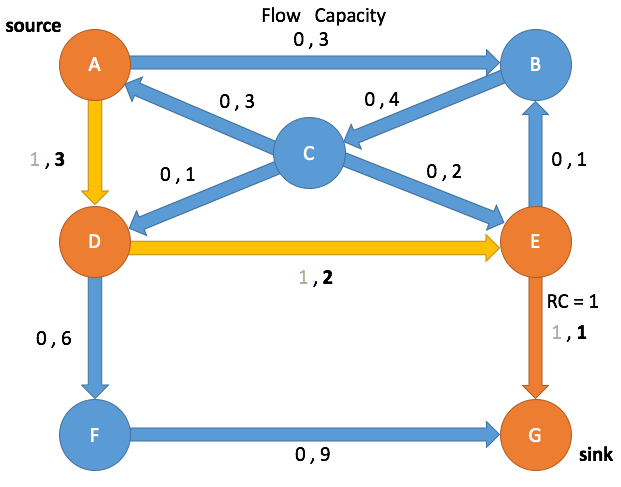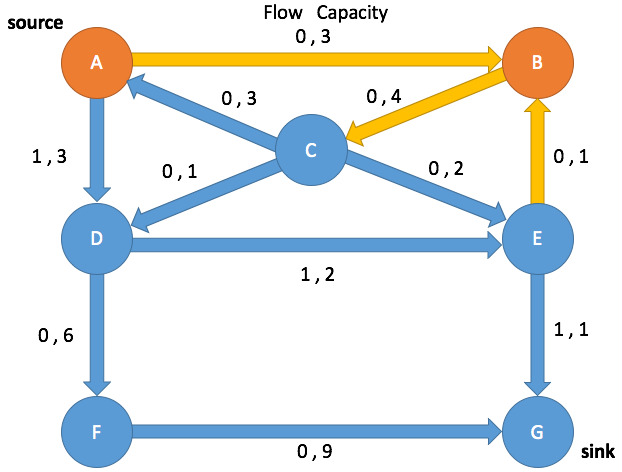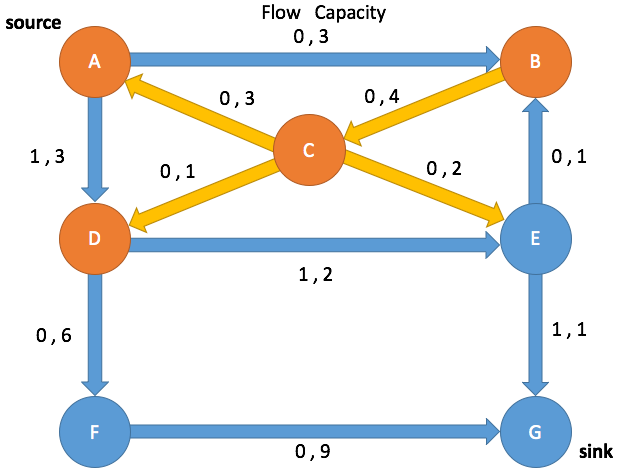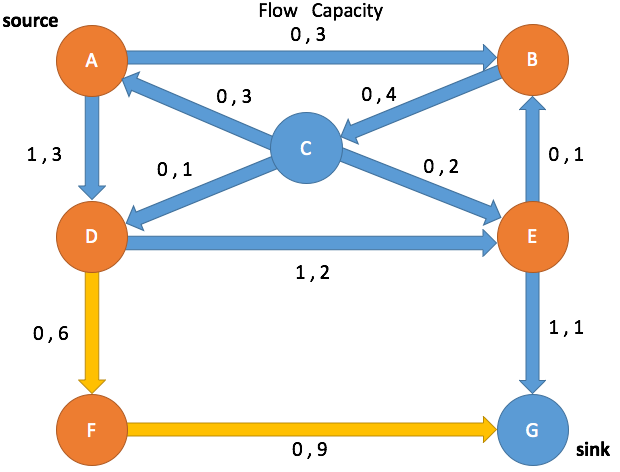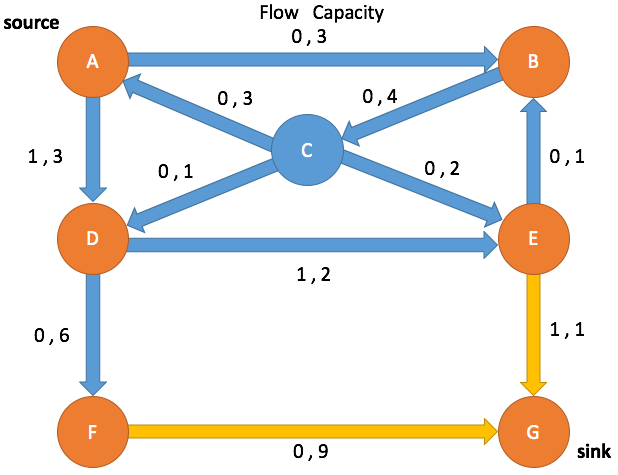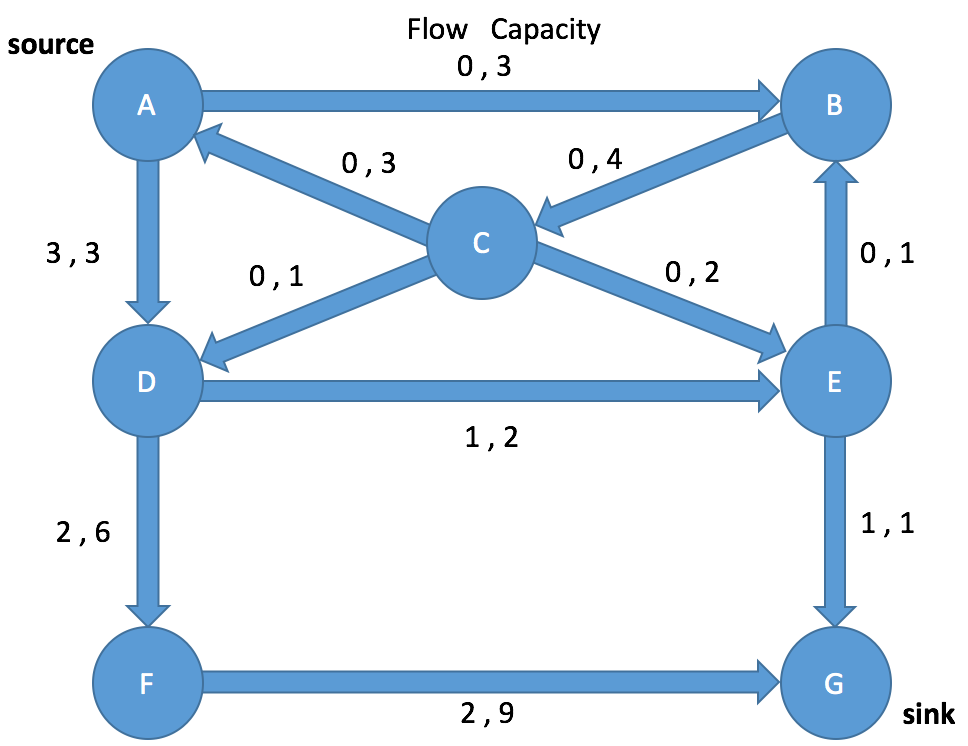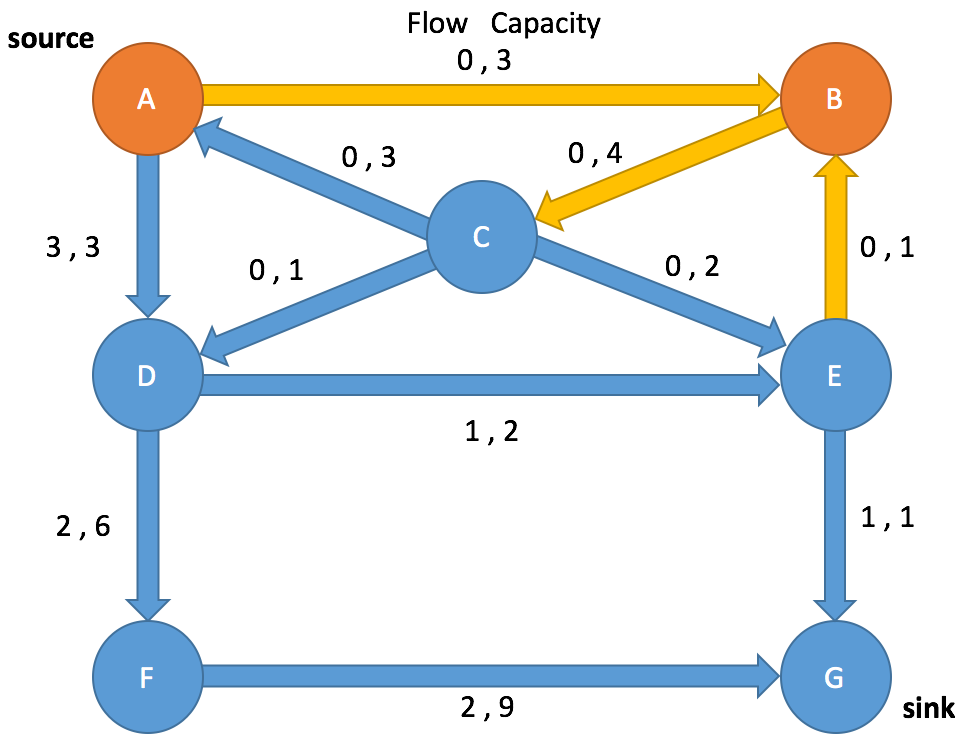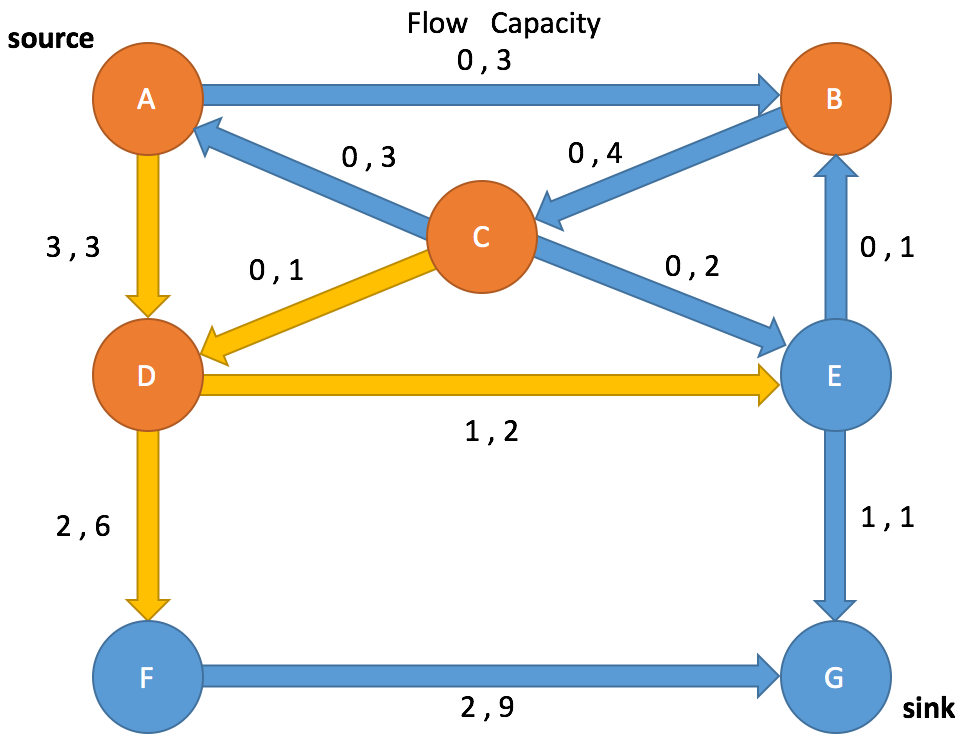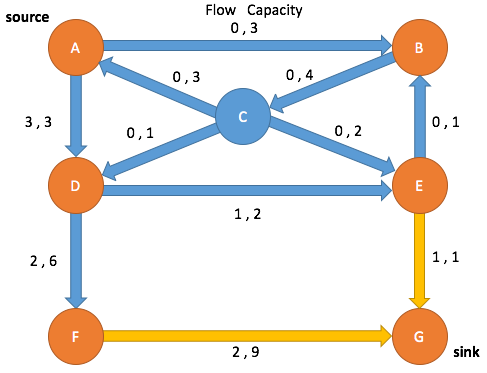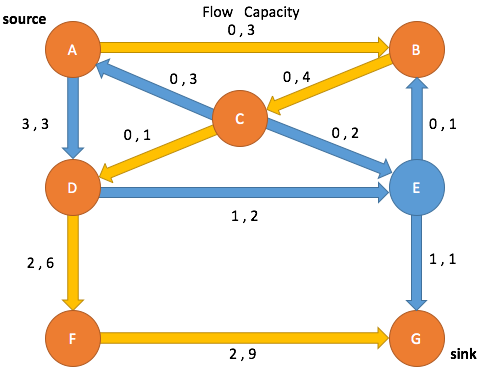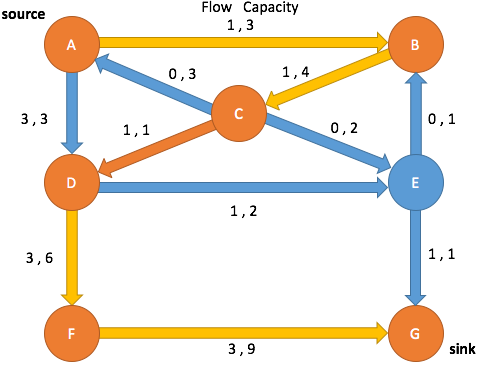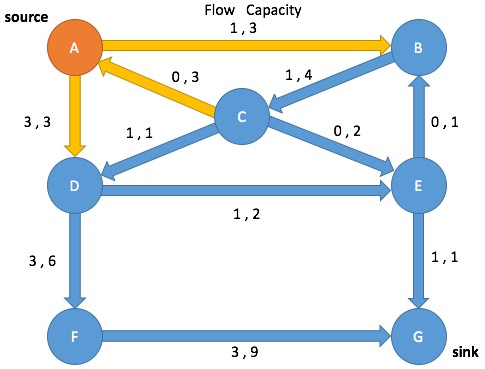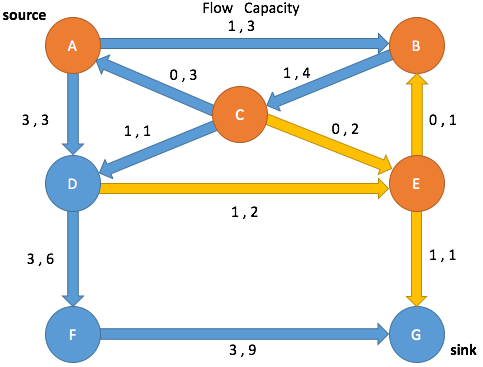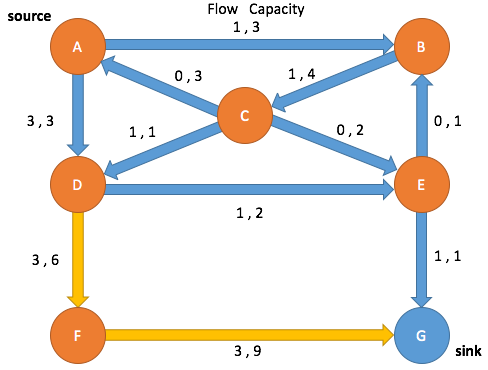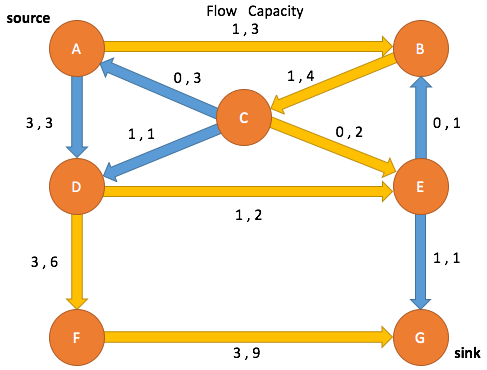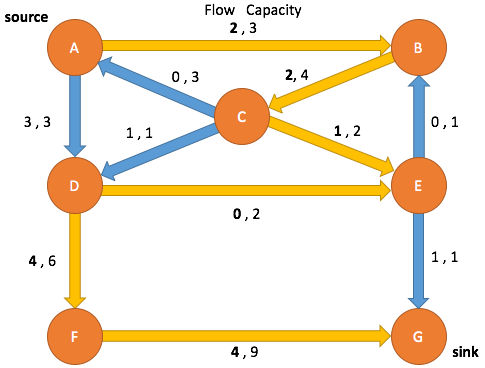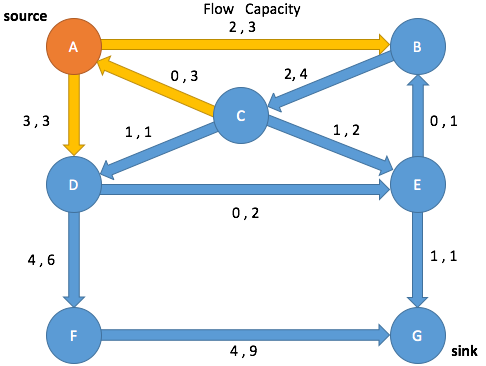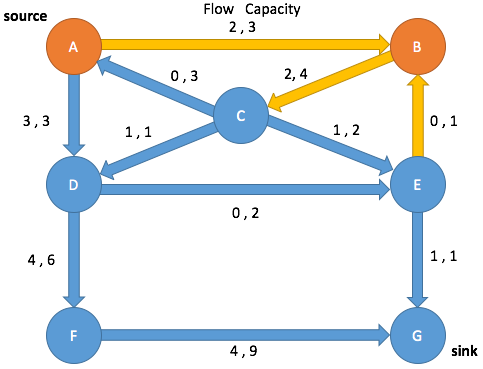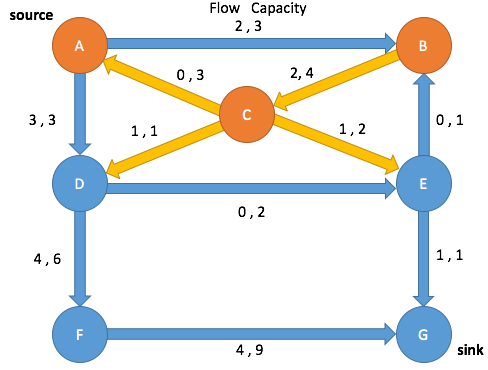Ford-Fulkerson Max Flow Algorithm
In this post I will step through the execution of the Ford-Fulkerson Max Flow algorithm using the Edmond-Karp Breadth First Search method. If you are learning this for the first time I suggest you watch this video tutorial, in which the same graph is used, and look at this Java source code for more implementation details.
Residual Graph
Ford-Fulkerson Algorithm
- Find an augmenting path
- Compute the bottleneck capacity
- Increase flow on that path by the bottleneck capacity
Path Search: Iteration 1
Enqueue A and mark as visited
|
A
|
|
Parent
|
To
|
Visited
|
Edge To |
Adjacent Edges (Edge, Flow, Capacity)
|
|
–
|
A | True |
–
|
(A→B, 0, 3) (A→D, 0, 3) (C→A, 0, 0)
|
|
–
|
B |
–
|
–
|
(A→B, 0, 3) (B→C, 0, 4) (E→B, 0, 1)
|
|
–
|
C |
–
|
–
|
(C→A, 0, 3) (B→C, 0, 4) (C→D, 0, 1) (C→E, 0, 2)
|
|
–
|
D |
–
|
–
|
(A→D, 0, 3) (C→D, 0, 1) (D→E, 0, 2) (D→F, 0, 6)
|
|
–
|
E |
–
|
–
|
(E→B, 0, 1) (C→E, 0, 2) (D→E, 0, 2) (E→G, 0, 1)
|
|
–
|
F |
–
|
–
|
(D→F, 0, 6) (F→G, 0, 9)
|
|
–
|
G |
–
|
–
|
(F→G, 0, 9) (E→G, 0, 1)
|
Dequeue A
|
A
|
|
edge
|
From
|
to |
visited(to)
|
residualCapacity(to)
|
residualCapacity(to) > 0 && visited(Vertex) == False
|
|
A→B
|
A
|
B
|
False
|
3 – 0 = 3
|
True
|
|
A→D
|
A
|
D
|
False
|
3 – 0 = 3
|
True
|
|
C→A
|
A
|
C
|
False
|
0 |
False
|
residualCapacity(Vertex to) {
if (to != edge.to()) {
return edge.flow;
}
else {
return edge.capacity - edge.flow;
}
|
Parent
|
To
|
Visited
|
Edge To
|
Adjacent Edges (Edge, Flow, Capacity)
|
|
–
|
A |
True
|
(A→B, 0, 3) (A→D, 0, 3) (C→A, 0, 0)
|
|
|
A
|
B
|
True
|
(A→B, 0, 3)
|
(A→B, 0, 3) (B→C, 0, 4) (E→B, 0, 1)
|
|
–
|
C |
–
|
(C→A, 0, 3) (B→C, 0, 4) (C→D, 0, 1) (C→E, 0, 2)
|
|
| A |
D
|
True
|
(A→D, 0, 3)
|
(A→D, 0, 3) (C→D, 0, 1) (D→E, 0, 2) (D→F, 0, 6)
|
|
–
|
E |
–
|
(E→B, 0, 1) (C→E, 0, 2) (D→E, 0, 2) (E→G, 0, 1)
|
|
|
–
|
F |
–
|
(D→F, 0, 6) (F→G, 0, 9)
|
|
|
–
|
G |
–
|
(F→G, 0, 9) (E→G, 0, 1)
|
Dequeue B
|
B
|
D
|
|
edge
|
From
|
to |
visited(to)
|
residualCapacity(to)
|
residualCapacity(to) > 0 && visited(Vertex) == False
|
|
A→B
|
B |
A
|
True
|
0 |
False
|
|
B→C
|
B
|
C
|
False
|
4 – 0 = 4
|
True
|
|
E→B
|
B
|
E
|
False
|
0 |
False
|
| Parent | To |
Visited
|
Edge To
|
Adjacent Edges (Edge, Flow, Capacity)
|
| – | A |
True
|
(A→B, 0, 3) (A→D, 0, 3) (C→A, 0, 0)
|
|
|
A
|
B |
True
|
(A→B, 0, 3)
|
(A→B, 0, 3) (B→C, 0, 4) (E→B, 0, 1)
|
| B | C |
True
|
(B→C, 0, 4)
|
(C→A, 0, 3) (B→C, 0, 4) (C→D, 0, 1) (C→E, 0, 2)
|
| A | D |
True
|
(A→D, 0, 3)
|
(A→D, 0, 3) (C→D, 0, 1) (D→E, 0, 2) (D→F, 0, 6)
|
| – |
E
|
–
|
(E→B, 0, 1) (C→E, 0, 2) (D→E, 0, 2) (E→G, 0, 1)
|
|
| – | F |
–
|
(D→F, 0, 6) (F→G, 0, 9)
|
|
| – | G |
–
|
(F→G, 0, 9) (E→G, 0, 1)
|
Dequeue D
|
D
|
C
|
|
edge
|
From
|
to |
visited(to)
|
residualCapacity(to)
|
residualCapacity(to) > 0 && visited(Vertex) == False
|
|
A→D
|
D
|
A
|
True
|
0 |
False
|
|
C→D
|
D
|
C
|
True
|
0 |
False
|
|
D→E
|
D
|
E
|
False
|
2
|
True
|
|
D→F
|
D
|
F
|
False
|
6
|
True
|
|
Parent
|
To
|
Visited
|
Edge To
|
Adjacent Edges (Edge, Flow, Capacity)
|
| – | A |
True
|
(A→B, 0, 3) (A→D, 0, 3) (C→A, 0, 0)
|
|
| A | B |
True
|
(A→B, 0, 3)
|
(A→B, 0, 3) (B→C, 0, 4) (E→B, 0, 1)
|
|
B
|
C |
True
|
(B→C, 0, 4)
|
(C→A, 0, 3) (B→C, 0, 4) (C→D, 0, 1) (C→E, 0, 2)
|
| A | D |
True
|
(A→D, 0, 3)
|
(A→D, 0, 3) (C→D, 0, 1) (D→E, 0, 2) (D→F, 0, 6)
|
|
D
|
E |
True
|
(D→E, 0, 2)
|
(E→B, 0, 1) (C→E, 0, 2) (D→E, 0, 2) (E→G, 0, 1)
|
|
D
|
F |
True
|
(D→F, 0, 6)
|
(D→F, 0, 6) (F→G, 0, 9)
|
| – | G |
–
|
(F→G, 0, 9) (E→G, 0, 1)
|
Dequeue C
|
C
|
E
|
F
|
|
edge
|
From
|
to |
visited(to)
|
residualCapacity(to)
|
residualCapacity(to) > 0 && visited(Vertex) == False
|
|
C→A
|
C
|
A
|
True
|
3 |
False
|
|
B→C
|
C
|
B
|
True
|
0 |
False
|
|
C→D
|
C
|
D
|
True
|
1
|
False
|
|
C→E
|
C
|
E
|
True
|
2
|
False
|
|
E
|
F
|
|
edge
|
From
|
to
|
visited(to)
|
residualCapacity(to)
|
residualCapacity(to) > 0 && visited(Vertex) == False
|
|
E→B
|
E
|
B |
True
|
1 |
False
|
|
C→E
|
E
|
C |
True
|
0 |
False
|
|
D→E
|
E
|
D
|
True
|
2 |
False
|
|
E→G
|
E
|
G
|
False
|
1 |
True
|
Data Structures
| Parent | To |
Visited
|
Edge To
|
Adjacent Edges (Edge, Flow, Capacity)
|
| – | A |
True
|
(A→B, 0, 3) (A→D, 0, 3) (C→A, 0, 0)
|
|
| A | B |
True
|
(A→B, 0, 3)
|
(A→B, 0, 3) (B→C, 0, 4) (E→B, 0, 1)
|
| B | C |
True
|
(B→C, 0, 4)
|
(C→A, 0, 3) (B→C, 0, 4) (C→D, 0, 1) (C→E, 0, 2)
|
| A | D |
True
|
(A→D, 0, 3)
|
(A→D, 0, 3) (C→D, 0, 1) (D→E, 0, 2) (D→F, 0, 6)
|
| D | E |
True
|
(D→E, 0, 2)
|
(E→B, 0, 1) (C→E, 0, 2) (D→E, 0, 2) (E→G, 0, 1)
|
| D | F |
True
|
(D→F, 0, 6)
|
(D→F, 0, 6) (F→G, 0, 9)
|
| E | G | True |
(E→G, 0, 1)
|
(F→G, 0, 9) (E→G, 0, 1)
|
Dequeue F
|
F
|
G
|
|
edge
|
From
|
to
|
visited(to)
|
residualCapacity(to)
|
residualCapacity(to) > 0 && visited(Vertex) == False
|
|
D→F
|
F
|
D
|
True
|
0 |
False
|
|
F→G
|
F
|
G
|
True | 9 | False |
Dequeue G
|
G
|
|
edge
|
From
|
to |
visited(to)
|
residualCapacity(to)
|
residualCapacity(to) > 0 && visited(Vertex) == False
|
|
E→G
|
G |
E
|
True
|
0 |
False
|
|
F→G
|
G
|
F
|
True
|
9 |
False
|
HALT: Queue Empty
Determining the Path
Determining the Bottleneck Capacity
bottleneck = Infinity;
v = Graph.sink();
while (v != Graph.source()) {
residualCapacity = edgeTo(v).residualCapacity();
bottleneck = Math.min(edgeTo(v).residualCapacity(), bottleneck);
v = parent(v);
}
| Parent | To |
Back Edge
|
Capacity | Flow |
Max Flow
|
Bottleneck (min flow) |
New Flow
|
Edge To Before
|
Edge To After
|
| A | D |
False
|
3 |
0
|
3 – 0 = 3
|
1
|
1
|
(A→D, 0, 3)
|
(A→D, 1, 3)
|
| D | E |
False
|
2 |
0
|
2 – 0 = 2
|
1
|
1
|
(D→E, 0, 2)
|
( (D→E, 1, 2)
|
| E | G |
False
|
1 |
0
|
1-0 = 1
|
1
|
1
|
(E→G, 0, 1)
|
(E→G, 1, 1)
|
Updating (Augmenting) the Path Edges
v = G.sink();
while (v != G.source()) {
edgeTo[v].addFlow(v, bottleneck);
v = parent[v];
}
Edge {
...
addFlow(toVertex, value) {
if (toVertex == from) {
flow = flow - value;
}
else {
flow = flow + value;
}
}
}
| Parent | To |
Path Bottleneck
|
Edge To Before
|
Edge To After
|
| A | D |
1
|
(A→D, 0, 3)
|
(A→D, 1, 3)
|
| D | E |
1
|
(D→E, 0, 2)
|
( (D→E, 1, 2)
|
| E | G |
1
|
(E→G, 0, 1)
|
(E→G, 1, 1)
|
Path Search: Iteration 2
Enqueue A and mark as visited
|
A
|
|
Parent
|
To
|
Visited
|
Edge To |
Adjacent Edges (Edge, Flow, Capacity)
|
|
–
|
A | True |
–
|
(A→B, 0, 3) (A→D, 1, 3) (C→A, 0, 0)
|
|
–
|
B |
–
|
–
|
(A→B, 0, 3) (B→C, 0, 4) (E→B, 0, 1)
|
|
–
|
C |
–
|
–
|
(C→A, 0, 3) (B→C, 0, 4) (C→D, 0, 1) (C→E, 0, 2)
|
|
–
|
D |
–
|
–
|
(A→D, 0, 1) (C→D, 0, 1) (D→E, 01, 2) (D→F, 0, 6)
|
|
–
|
E |
–
|
–
|
(E→B, 0, 1) (C→E, 0, 2) (D→E, 1, 2) (E→G, 1, 1)
|
|
–
|
F |
–
|
–
|
(D→F, 0, 6) (F→G, 0, 9)
|
|
–
|
G |
–
|
–
|
(F→G, 0, 9) (E→G, 1, 1)
|
Dequeue A
|
A
|
|
edge
|
From
|
to |
visited(to)
|
residualCapacity(to)
|
residualCapacity(to) > 0 && visited(Vertex) == False
|
|
A→B
|
A
|
B
|
False
|
3 |
True
|
|
A→D
|
A
|
D
|
False
|
3 – 1 = 2
|
True
|
|
C→A
|
A
|
C
|
False
|
0 | False |
|
Parent
|
To
|
Visited
|
Edge To |
Adjacent Edges (Edge, Flow, Capacity)
|
|
–
|
A | True |
–
|
(A→B, 0, 3) (A→D, 1, 3) (C→A, 0, 0)
|
| A | B | True |
(A→B, 0, 3)
|
(A→B, 0, 3) (B→C, 0, 4) (E→B, 0, 1)
|
|
–
|
C |
–
|
–
|
(C→A, 0, 3) (B→C, 0, 4) (C→D, 0, 1) (C→E, 0, 2)
|
| A | D |
True
|
(A→D, 1, 3)
|
(A→D, 0, 1) (C→D, 0, 1) (D→E, 01, 2) (D→F, 0, 6)
|
|
–
|
E |
–
|
–
|
(E→B, 0, 1) (C→E, 0, 2) (D→E, 1, 2) (E→G, 1, 1)
|
|
–
|
F |
–
|
–
|
(D→F, 0, 6) (F→G, 0, 9)
|
|
–
|
G |
–
|
–
|
(F→G, 0, 9) (E→G, 1, 1)
|
Dequeue B
|
B
|
D
|
|
edge
|
From
|
to |
visited(to)
|
residualCapacity(to)
|
residualCapacity(to) > 0 && visited(Vertex) == False
|
|
A→B
|
B |
A
|
True
|
0 |
False
|
|
B→C
|
B
|
C
|
False
|
4
|
True
|
|
E→B
|
B
|
E
|
False
|
0 |
False
|
|
Parent
|
To
|
Visited
|
Edge To |
Adjacent Edges (Edge, Flow, Capacity)
|
|
–
|
A | True |
–
|
(A→B, 0, 3) (A→D, 1, 3) (C→A, 0, 0)
|
| A | B | True |
(A→B, 0, 3)
|
(A→B, 0, 3) (B→C, 0, 4) (E→B, 0, 1)
|
|
B
|
C | True |
(B→C, 0, 4)
|
(C→A, 0, 3) (B→C, 0, 4) (C→D, 0, 1) (C→E, 0, 2)
|
| A | D |
True
|
(A→D, 1, 3)
|
(A→D, 0, 1) (C→D, 0, 1) (D→E, 01, 2) (D→F, 0, 6)
|
|
–
|
E |
–
|
–
|
(E→B, 0, 1) (C→E, 0, 2) (D→E, 1, 2) (E→G, 1, 1)
|
|
–
|
F |
–
|
–
|
(D→F, 0, 6) (F→G, 0, 9)
|
|
–
|
G |
–
|
–
|
(F→G, 0, 9) (E→G, 1, 1)
|
Dequeue D
|
D
|
C
|
|
edge
|
From
|
to |
visited(to)
|
residualCapacity(to)
|
residualCapacity(to) > 0 && visited(Vertex) == False
|
|
A→D
|
D
|
A
|
True
|
1 |
False
|
|
C→D
|
D
|
C
|
True
|
0 |
False
|
|
D→E
|
D
|
E
|
False
|
1 |
True
|
|
D→F
|
D
|
F
|
False
|
6
|
True
|
|
Parent
|
To
|
Visited
|
Edge To |
Adjacent Edges (Edge, Flow, Capacity)
|
|
–
|
A | True |
–
|
(A→B, 0, 3) (A→D, 1, 3) (C→A, 0, 0)
|
| A | B | True |
(A→B, 0, 3)
|
(A→B, 0, 3) (B→C, 0, 4) (E→B, 0, 1)
|
|
B
|
C | True |
(B→C, 0, 4)
|
(C→A, 0, 3) (B→C, 0, 4) (C→D, 0, 1) (C→E, 0, 2)
|
| A | D |
True
|
(A→D, 1, 3)
|
(A→D, 0, 1) (C→D, 0, 1) (D→E, 01, 2) (D→F, 0, 6)
|
|
D
|
E | True |
(D→E, 01, 2)
|
(E→B, 0, 1) (C→E, 0, 2) (D→E, 1, 2) (E→G, 1, 1)
|
|
D
|
F | True |
(D→F, 0, 6)
|
(D→F, 0, 6) (F→G, 0, 9)
|
|
–
|
G |
–
|
–
|
(F→G, 0, 9) (E→G, 1, 1)
|
Dequeue C
|
C
|
E
|
F
|
|
edge
|
From
|
to |
visited(to)
|
residualCapacity(to)
|
residualCapacity(to) > 0 && visited(Vertex) == False
|
|
C→A
|
C
|
A
|
True
|
3
|
False
|
|
B→C
|
C
|
B
|
True
|
0 |
False
|
|
C→D
|
C
|
D
|
True
|
2 |
False
|
|
C→E
|
C
|
E
|
True
|
2 |
False
|
Dequeue E
|
E
|
F
|
|
edge
|
From
|
to
|
visited(to)
|
residualCapacity(to)
|
residualCapacity(to) > 0 && visited(Vertex) == False
|
|
E→B
|
E
|
B |
True
|
1 |
False
|
|
C→E
|
E
|
C |
True
|
0 |
False
|
|
D→E
|
E
|
D
|
True
|
1 |
False
|
|
E→G
|
E
|
G
|
False
|
0 |
False
|
Dequeue F
|
F
|
|
edge
|
From
|
to
|
visited(to)
|
residualCapacity(to)
|
residualCapacity(to) > 0 && visited(Vertex) == False
|
|
D→F
|
F
|
D
|
True
|
0 |
False
|
|
F→G
|
F
|
G
|
False | 9 | True |
Data Structures
|
Parent
|
To
|
Visited
|
Edge To |
Adjacent Edges (Edge, Flow, Capacity)
|
|
–
|
A | True |
–
|
(A→B, 0, 3) (A→D, 1, 3) (C→A, 0, 0)
|
| A | B | True |
(A→B, 0, 3)
|
(A→B, 0, 3) (B→C, 0, 4) (E→B, 0, 1)
|
|
B
|
C | True |
(B→C, 0, 4)
|
(C→A, 0, 3) (B→C, 0, 4) (C→D, 0, 1) (C→E, 0, 2)
|
| A | D |
True
|
(A→D, 1, 3)
|
(A→D, 0, 1) (C→D, 0, 1) (D→E, 01, 2) (D→F, 0, 6)
|
|
D
|
E | True |
(D→E, 01, 2)
|
(E→B, 0, 1) (C→E, 0, 2) (D→E, 1, 2) (E→G, 1, 1)
|
|
D
|
F | True |
(D→F, 0, 6)
|
(D→F, 0, 6) (F→G, 0, 9)
|
| F | G | True |
(F→G, 0, 9)
|
(F→G, 0, 9) (E→G, 1, 1)
|
Dequeue G
| G |
|
edge
|
From
|
to |
visited(to)
|
residualCapacity(to)
|
residualCapacity(to) > 0 && visited(Vertex) == False
|
|
E→G
|
G
|
E
|
True
|
1 |
False
|
|
F→G
|
G |
F
|
True
|
0 |
False
|
HALT: Queue Empty
Determining the Path
Determining the Bottleneck Capacity
| Parent | To |
Back Edge
|
Capacity | Flow |
Max Flow
|
Bottleneck (min flow) |
New Flow
|
Edge To Before
|
Edge To After
|
| A | D |
False
|
3 | 1 |
2
|
2 | 3 |
(A→D, 1, 3)
|
(A→D, 3, 3)
|
| D | F |
False
|
6 | 0 |
6
|
2 | 2 |
(D→F, 0, 6)
|
( (D→F, 2, 6)
|
| F | G |
False
|
9 |
0
|
9 | 2 | 2 |
(F→G, 0, 9)
|
(F→G, 2, 9)
|
Updating (Augmenting) the Path Edges
| Parent | To |
Path Bottleneck
|
Edge To Before
|
Edge To After
|
| A | D | 2 |
(A→D, 1, 3)
|
(A→D, 3, 3)
|
| D | F | 2 |
(D→F, 0, 6)
|
(D→F, 2, 6)
|
| F | G | 2 |
(F→G, 0, 9)
|
(F→G, 2, 9)
|
Path Search: Iteration 3
Enqueue A and mark as visited
|
A
|
|
Parent
|
To
|
Visited
|
Edge To |
Adjacent Edges (Edge, Flow, Capacity)
|
|
–
|
A | True |
–
|
(A→B, 0 3) (A→D, 3, 3) (C→A, 0, 0)
|
| – | B | – |
–
|
(A→B, 0, 3) (B→C, 0, 4) (E→B, 0, 1)
|
| – | C | – |
–
|
(C→A, 0, 3) (B→C, 0, 4) (C→D, 0, 1) (C→E, 0, 2)
|
| – | D |
–
|
–
|
(A→D, 3, 3) (C→D, 0, 1) (D→E, 01, 2) (D→F, 2, 6)
|
| – | E | – |
–
|
(E→B, 0, 1) (C→E, 0, 2) (D→E, 1, 2) (E→G, 1, 1)
|
| – | F | – |
–
|
(D→F, 2, 6) (F→G, 2, 9)
|
| – | G | – |
–
|
(F→G, 2, 9) (E→G, 1, 1)
|
Dequeue A
|
A
|
|
edge
|
From
|
to |
visited(to)
|
residualCapacity(to)
|
residualCapacity(to) > 0 && visited(Vertex) == False
|
|
A→B
|
A
|
B
|
False
|
3
|
True
|
|
A→D
|
A
|
D
|
False
|
0 | False |
|
C→A
|
A
|
C
|
False
|
0 | False |
|
Parent
|
To
|
Visited
|
Edge To |
Adjacent Edges (Edge, Flow, Capacity)
|
|
–
|
A | True |
–
|
(A→B, 0, 3) (A→D, 3, 3) (C→A, 0, 0)
|
| A | B | True |
(A→B, 0, 3)
|
(A→B, 0, 3) (B→C, 0, 4) (E→B, 0, 1)
|
| – | C | – |
–
|
(C→A, 0, 3) (B→C, 0, 4) (C→D, 0, 1) (C→E, 0, 2)
|
| – | D |
–
|
–
|
(A→D, 3, 3) (C→D, 0, 1) (D→E, 01, 2) (D→F, 2, 6)
|
| – | E | – |
–
|
(E→B, 0, 1) (C→E, 0, 2) (D→E, 1, 2) (E→G, 1, 1)
|
| – | F | – |
–
|
(D→F, 2, 6) (F→G, 2, 9)
|
| – | G | – |
–
|
(F→G, 2, 9) (E→G, 1, 1)
|
Dequeue B
|
B
|
|
edge
|
From
|
to |
visited(to)
|
residualCapacity(to)
|
residualCapacity(to) > 0 && visited(Vertex) == False
|
|
A→B
|
B |
A
|
True
|
0 |
False
|
|
B→C
|
B
|
C
|
False
|
4
|
True
|
|
E→B
|
B
|
E
|
False
|
0 |
False
|
|
Parent
|
To
|
Visited
|
Edge To |
Adjacent Edges (Edge, Flow, Capacity)
|
|
–
|
A | True |
–
|
(A→B, 0, 3) (A→D, 3, 3) (C→A, 0, 0)
|
| A | B | True |
(A→B, 0, 3)
|
(A→B, 0, 3) (B→C, 0, 4) (E→B, 0, 1)
|
| B | C | True |
(B→C, 0, 4)
|
(C→A, 0, 3) (B→C, 0, 4) (C→D, 0, 1) (C→E, 0, 2)
|
| – | D |
–
|
–
|
(A→D, 3, 3) (C→D, 0, 1) (D→E, 01, 2) (D→F, 2, 6)
|
| – | E | – |
–
|
(E→B, 0, 1) (C→E, 0, 2) (D→E, 1, 2) (E→G, 1, 1)
|
| – | F | – |
–
|
(D→F, 2, 6) (F→G, 2, 9)
|
| – | G | – |
–
|
(F→G, 2, 9) (E→G, 1, 1)
|
Dequeue C
|
C
|
|
edge
|
From
|
to |
visited(to)
|
residualCapacity(to)
|
residualCapacity(to) > 0 && visited(Vertex) == False
|
|
C→A
|
C
|
A
|
True | 3 | False |
|
B→C
|
C
|
B
|
True | 0 | False |
|
C→D
|
C
|
D
|
False | 1 | True |
|
C→E
|
C
|
E
|
False | 2 | True |
|
Parent
|
To
|
Visited
|
Edge To |
Adjacent Edges (Edge, Flow, Capacity)
|
|
–
|
A | True |
–
|
(A→B, 0, 3) (A→D, 3, 3) (C→A, 0, 0)
|
| A | B | True |
(A→B, 0, 3)
|
(A→B, 0, 3) (B→C, 0, 4) (E→B, 0, 1)
|
| B | C | True |
(B→C, 0, 4)
|
(C→A, 0, 3) (B→C, 0, 4) (C→D, 0, 1) (C→E, 0, 2)
|
| C | D | True |
(C→D, 0, 1)
|
(A→D, 3, 3) (C→D, 0, 1) (D→E, 1, 2) (D→F, 2, 6)
|
|
C
|
E | True |
(C→E, 0, 2)
|
(E→B, 0, 1) (C→E, 0, 2) (D→E, 1, 2) (E→G, 1, 1)
|
| – | F | – |
–
|
(D→F, 2, 6) (F→G, 2, 9)
|
| – | G | – |
–
|
(F→G, 2, 9) (E→G, 1, 1)
|
Dequeue D
| D |
E
|
|
edge
|
From
|
to |
visited(to)
|
residualCapacity(to)
|
residualCapacity(to) > 0 && visited(Vertex) == False
|
|
A→D
|
D
|
A
|
True
|
3 |
False
|
|
C→D
|
D
|
C
|
True
|
0 |
False
|
|
D→E
|
D
|
E
|
True
|
1 |
True
|
|
D→F
|
D
|
F
|
False
|
4 |
True
|
|
Parent
|
To
|
Visited
|
Edge To |
Adjacent Edges (Edge, Flow, Capacity)
|
|
–
|
A | True |
–
|
(A→B, 0, 3) (A→D, 3, 3) (C→A, 0, 0)
|
| A | B | True |
(A→B, 0, 3)
|
(A→B, 0, 3) (B→C, 0, 4) (E→B, 0, 1)
|
| B | C | True |
(B→C, 0, 4)
|
(C→A, 0, 3) (B→C, 0, 4) (C→D, 0, 1) (C→E, 0, 2)
|
| C | D | True |
(C→D, 0, 1)
|
(A→D, 3, 3) (C→D, 0, 1) (D→E, 1, 2) (D→F, 2, 6)
|
|
C
|
E | True |
(C→E, 0, 2)
|
(E→B, 0, 1) (C→E, 0, 2) (D→E, 1, 2) (E→G, 1, 1)
|
| D | F | True |
(D→F, 2, 6)
|
(D→F, 2, 6) (F→G, 2, 9)
|
| – | G | – |
–
|
(F→G, 2, 9) (E→G, 1, 1)
|
Dequeue E
| E | F |
|
edge
|
From
|
to
|
visited(to)
|
residualCapacity(to)
|
residualCapacity(to) > 0 && visited(Vertex) == False
|
|
E→B
|
E
|
B |
True
|
1 |
False
|
|
C→E
|
E
|
C |
True
|
0 |
False
|
|
D→E
|
E
|
D
|
True
|
1 |
False
|
|
E→G
|
E
|
G
|
False
|
0 |
False
|
Dequeue F
| F |
|
edge
|
From
|
to
|
visited(to)
|
residualCapacity(to)
|
residualCapacity(to) > 0 && visited(Vertex) == False
|
|
D→F
|
F
|
D
|
True
|
2 |
False
|
|
F→G
|
F
|
G
|
False | 7 | True |
Mark vertices G as visited, add it to the Queue, set its parent to F, and add the edge.
|
Parent
|
To
|
Visited
|
Edge To |
Adjacent Edges (Edge, Flow, Capacity)
|
|
–
|
A | True |
–
|
(A→B, 0, 3) (A→D, 3, 3) (C→A, 0, 0)
|
| A | B | True |
(A→B, 0, 3)
|
(A→B, 0, 3) (B→C, 0, 4) (E→B, 0, 1)
|
| B | C | True |
(B→C, 0, 4)
|
(C→A, 0, 3) (B→C, 0, 4) (C→D, 0, 1) (C→E, 0, 2)
|
| C | D | True |
(C→D, 0, 1)
|
(A→D, 3, 3) (C→D, 0, 1) (D→E, 1, 2) (D→F, 2, 6)
|
|
C
|
E | True |
(C→E, 0, 2)
|
(E→B, 0, 1) (C→E, 0, 2) (D→E, 1, 2) (E→G, 1, 1)
|
| D | F | True |
(D→F, 2, 6)
|
(D→F, 2, 6) (F→G, 2, 9)
|
| F | G | True |
(F→G, 2, 9)
|
(F→G, 2, 9) (E→G, 1, 1)
|
Dequeue G
| G |
|
edge
|
From
|
to |
visited(to)
|
residualCapacity(to)
|
residualCapacity(to) > 0 && visited(Vertex) == False
|
|
E→G
|
G |
E
|
True
|
0 |
False
|
|
F→G
|
G |
F
|
True
|
2 |
False
|
Nothing to add.
HALT: Queue Empty
Determining the Path
Determining the Bottleneck Capacity
| Parent | To |
Back Edge
|
Capacity | Flow |
Max Flow
|
Bottleneck (min flow) |
New Flow
|
Edge To Before
|
Edge To After
|
| A | B |
False
|
3 | 0 | 3 | 1 | 1 |
(A→B, 0, 3)
|
(A→B, 1, 3)
|
| B | C |
False
|
4 | 0 | 4 | 1 | 1 |
(B→C, 0, 4)
|
(B→C, 1, 4)
|
| C | D |
False
|
1 | 0 | 1 | 1 | 1 |
(C→D, 0, 1)
|
(C→D, 1, 1)
|
|
D
|
F
|
False
|
6 |
2
|
4
|
1
|
3
|
(D→F, 2, 6)
|
(D→F, 3, 6)
|
|
F
|
G
|
False
|
9
|
2
|
7
|
1
|
3
|
(F→G, 2, 9)
|
(F→G, 3, 9)
|
Path Search: Iteration 4
Enqueue A and mark as visited
|
A
|
|
Parent
|
To
|
Visited
|
Edge To |
Adjacent Edges (Edge, Flow, Capacity)
|
|
–
|
A | True |
–
|
(A→B, 1, 3) (A→D, 3, 3) (C→A, 0, 0)
|
| – | B | – |
–
|
(A→B, 1, 3) (B→C, 1, 4) (E→B, 0, 1)
|
| – | C | – |
–
|
(C→A, 0, 3) (B→C, 1, 4) (C→D, 1, 1) (C→E, 0, 2)
|
| – | D | – |
–
|
(A→D, 3, 3) (C→D, 1, 1) (D→E, 1, 2) (D→F, 3, 6)
|
| – | E | – | – |
(E→B, 0, 1) (C→E, 0, 2) (D→E, 1, 2) (E→G, 1, 1)
|
| – | F | – |
–
|
(D→F, 3, 6) (F→G, 3, 9)
|
| – | G | – |
–
|
(F→G, 3, 9) (E→G, 1, 1)
|
Dequeue A
|
A
|
|
edge
|
From
|
to |
visited(to)
|
residualCapacity(to)
|
residualCapacity(to) > 0 && visited(Vertex) == False
|
|
A→B
|
A
|
B
|
False
|
2 | True |
|
A→D
|
A
|
D
|
False
|
0 | False |
|
C→A
|
A
|
C
|
False
|
0 | False |
|
Parent
|
To
|
Visited
|
Edge To |
Adjacent Edges (Edge, Flow, Capacity)
|
|
–
|
A | True |
–
|
(A→B, 1, 3) (A→D, 3, 3) (C→A, 0, 0)
|
| A | B | True |
(A→B, 1, 3)
|
(A→B, 1, 3) (B→C, 1, 4) (E→B, 0, 1)
|
| – | C | – |
–
|
(C→A, 0, 3) (B→C, 1, 4) (C→D, 1, 1) (C→E, 0, 2)
|
| – | D | – |
–
|
(A→D, 3, 3) (C→D, 1, 1) (D→E, 1, 2) (D→F, 3, 6)
|
| – | E | – | – |
(E→B, 0, 1) (C→E, 0, 2) (D→E, 1, 2) (E→G, 1, 1)
|
| – | F | – |
–
|
(D→F, 3, 6) (F→G, 3, 9)
|
| – | G | – |
–
|
(F→G, 3, 9) (E→G, 1, 1)
|
Dequeue B
|
B
|
|
edge
|
From
|
to |
visited(to)
|
residualCapacity(to)
|
residualCapacity(to) > 0 && visited(Vertex) == False
|
|
A→B
|
B |
A
|
True |
1
|
False
|
|
B→C
|
B
|
C
|
False | 3 | True |
|
E→B
|
B
|
E
|
False | 0 | False |
|
Parent
|
To
|
Visited
|
Edge To |
Adjacent Edges (Edge, Flow, Capacity)
|
|
–
|
A | True |
–
|
(A→B, 1, 3) (A→D, 3, 3) (C→A, 0, 0)
|
| A | B | True |
(A→B, 1, 3)
|
(A→B, 1, 3) (B→C, 1, 4) (E→B, 0, 1)
|
| B | C | True |
(B→C, 1, 4)
|
(C→A, 0, 3) (B→C, 1, 4) (C→D, 1, 1) (C→E, 0, 2)
|
| – | D | – |
–
|
(A→D, 3, 3) (C→D, 1, 1) (D→E, 1, 2) (D→F, 3, 6)
|
| – | E | – | – |
(E→B, 0, 1) (C→E, 0, 2) (D→E, 1, 2) (E→G, 1, 1)
|
| – | F | – |
–
|
(D→F, 3, 6) (F→G, 3, 9)
|
| – | G | – |
–
|
(F→G, 3, 9) (E→G, 1, 1)
|
Dequeue C
|
C
|
|
edge
|
From
|
to |
visited(to)
|
residualCapacity(to)
|
residualCapacity(to) > 0 && visited(Vertex) == False
|
|
C→A
|
C
|
A
|
True
|
3
|
False
|
|
B→C
|
C
|
B
|
True |
1
|
False
|
|
C→D
|
C
|
D
|
False |
0
|
False
|
|
C→E
|
C
|
E
|
False |
2
|
True
|
Mark vertices E as visited, add it to the queue, set C as its parent, and add the edge to E.
|
Parent
|
To
|
Visited
|
Edge To |
Adjacent Edges (Edge, Flow, Capacity)
|
|
–
|
A | True |
–
|
(A→B, 1, 3) (A→D, 3, 3) (C→A, 0, 0)
|
| A | B | True |
(A→B, 1, 3)
|
(A→B, 1, 3) (B→C, 1, 4) (E→B, 0, 1)
|
| B | C | True |
(B→C, 1, 4)
|
(C→A, 0, 3) (B→C, 1, 4) (C→D, 1, 1) (C→E, 0, 2)
|
| – | D | – |
–
|
(A→D, 3, 3) (C→D, 1, 1) (D→E, 1, 2) (D→F, 3, 6)
|
| C | E | True |
(C→E, 0, 2)
|
(E→B, 0, 1) (C→E, 0, 2) (D→E, 1, 2) (E→G, 1, 1)
|
| – | F | – |
–
|
(D→F, 3, 6) (F→G, 3, 9)
|
| – | G | – |
–
|
(F→G, 3, 9) (E→G, 1, 1)
|
Dequeue E
| E |
|
edge
|
From
|
to
|
visited(to)
|
residualCapacity(to)
|
residualCapacity(to) > 0 && visited(Vertex) == False
|
|
E→B
|
E
|
B |
True
|
1
|
False |
|
C→E
|
E
|
C |
True
|
0
|
False
|
|
D→E
|
E
|
D
|
False
|
1
|
True
|
|
E→G
|
E
|
G
|
False
|
0
|
False
|
Mark vertices D as visited, add it to the queue, set E as its parent, and add the edge to D.
|
Parent
|
To
|
Visited
|
Edge To |
Adjacent Edges (Edge, Flow, Capacity)
|
|
–
|
A | True |
–
|
(A→B, 1, 3) (A→D, 3, 3) (C→A, 0, 0)
|
| A | B | True |
(A→B, 1, 3)
|
(A→B, 1, 3) (B→C, 1, 4) (E→B, 0, 1)
|
| B | C | True |
(B→C, 1, 4)
|
(C→A, 0, 3) (B→C, 1, 4) (C→D, 1, 1) (C→E, 0, 2)
|
| E | D | True |
(D→E, 1, 2)
|
(A→D, 3, 3) (C→D, 1, 1) (D→E, 1, 2) (D→F, 3, 6)
|
| C | E | True |
(C→E, 0, 2)
|
(E→B, 0, 1) (C→E, 0, 2) (D→E, 1, 2) (E→G, 1, 1)
|
| – | F | – |
–
|
(D→F, 3, 6) (F→G, 3, 9)
|
| – | G | – |
–
|
(F→G, 3, 9) (E→G, 1, 1)
|
Dequeue D
| D |
|
edge
|
From
|
to |
visited(to)
|
residualCapacity(to)
|
residualCapacity(to) > 0 && visited(Vertex) == False
|
|
A→D
|
D
|
A
|
True
|
0
|
False
|
|
C→D
|
D
|
C
|
True
|
1 |
False
|
|
D→E
|
D
|
E
|
True
|
1
|
False
|
|
D→F
|
D
|
F
|
False
|
3
|
True
|
|
Parent
|
To
|
Visited
|
Edge To |
Adjacent Edges (Edge, Flow, Capacity)
|
|
–
|
A | True |
–
|
(A→B, 1, 3) (A→D, 3, 3) (C→A, 0, 0)
|
| A | B | True |
(A→B, 1, 3)
|
(A→B, 1, 3) (B→C, 1, 4) (E→B, 0, 1)
|
| B | C | True |
(B→C, 1, 4)
|
(C→A, 0, 3) (B→C, 1, 4) (C→D, 1, 1) (C→E, 0, 2)
|
| E | D | True |
(D→E, 1, 2)
|
(A→D, 3, 3) (C→D, 1, 1) (D→E, 1, 2) (D→F, 3, 6)
|
| C | E | True |
(C→E, 0, 2)
|
(E→B, 0, 1) (C→E, 0, 2) (D→E, 1, 2) (E→G, 1, 1)
|
| D | F | True |
(D→F, 3, 6)
|
(D→F, 3, 6) (F→G, 3, 9)
|
| – | G | – |
–
|
(F→G, 3, 9) (E→G, 1, 1)
|
Dequeue F
| F |
|
edge
|
From
|
to
|
visited(to)
|
residualCapacity(to)
|
residualCapacity(to) > 0 && visited(Vertex) == False
|
|
D→F
|
F
|
D
|
True |
3
|
False
|
|
F→G
|
F
|
G
|
False
|
6
|
True
|
|
Parent
|
To
|
Visited
|
Edge To |
Adjacent Edges (Edge, Flow, Capacity)
|
|
–
|
A | True |
–
|
(A→B, 1, 3) (A→D, 3, 3) (C→A, 0, 0)
|
| A | B | True |
(A→B, 1, 3)
|
(A→B, 1, 3) (B→C, 1, 4) (E→B, 0, 1)
|
| B | C | True |
(B→C, 1, 4)
|
(C→A, 0, 3) (B→C, 1, 4) (C→D, 1, 1) (C→E, 0, 2)
|
| E | D | True |
(D→E, 1, 2)
|
(A→D, 3, 3) (C→D, 1, 1) (D→E, 1, 2) (D→F, 3, 6)
|
| C | E | True |
(C→E, 0, 2)
|
(E→B, 0, 1) (C→E, 0, 2) (D→E, 1, 2) (E→G, 1, 1)
|
| D | F | True |
(D→F, 3, 6)
|
(D→F, 3, 6) (F→G, 3, 9)
|
| F | G | True |
(F→G, 3, 9)
|
(F→G, 3, 9) (E→G, 1, 1)
|
Dequeue G
| G |
|
edge
|
From
|
to |
visited(to)
|
residualCapacity(to)
|
residualCapacity(to) > 0 && visited(Vertex) == False
|
|
E→G
|
G
|
E |
True
|
1 | False |
|
F→G
|
G |
F
|
True
|
3
|
False
|
Nothing to add.
HALT: Queue Empty
Determining the Path
Determining the Bottleneck Capacity
| Parent | To |
Back Edge
|
Capacity | Flow |
Max Flow
|
Bottleneck (min flow) |
New Flow
|
Edge To Before
|
Edge To After
|
| A | B |
False
|
3 | 1 | 2 | 1 | 2 |
(A→B, 1, 3)
|
(A→B, 2, 3)
|
| B | C |
False
|
4 | 1 | 3 | 1 | 2 |
(B→C, 1, 4)
|
(B→C, 2, 4)
|
| C | E |
False
|
2 | 0 | 2 | 1 | 1 |
(C→E, 0, 2)
|
(C→E, 1, 2)
|
| E |
D
|
True
|
2 | 1 | 1 | 1 | 0 |
(D→E, 1, 2)
|
(D→E, 0, 2)
|
| D |
F
|
False
|
6 | 3 | 3 | 1 | 4 |
(D→F, 3, 6)
|
(D→F, 4, 6)
|
|
F
|
G |
False
|
9
|
3
|
6
|
1
|
4
|
(F→G, 3, 9)
|
(F→G, 4, 9)
|
Path Search: Iteration 5
Enqueue A and mark as visited
|
A
|
|
Parent
|
To
|
Visited
|
Edge To |
Adjacent Edges (Edge, Flow, Capacity)
|
|
–
|
A | True |
–
|
(A→B, 2, 3) (A→D, 3, 3) (C→A, 0, 0)
|
| – | B | – |
–
|
(A→B, 2, 3) (B→C, 2, 4) (E→B, 0, 1)
|
| – | C | – |
–
|
(C→A, 0, 3) (B→C, 2, 4) (C→D, 1, 1) (C→E, 1, 2)
|
| – | D | – |
–
|
(A→D, 3, 3) (C→D, 1, 1) (D→E, 0, 2) (D→F, 4, 6)
|
| – | E | – |
–
|
(E→B, 0, 1) (C→E, 1, 2) (D→E, 0, 2) (E→G, 1, 1)
|
| – | F | – |
–
|
(D→F, 4, 6) (F→G, 4, 9)
|
| – | G | – |
–
|
(F→G, 4, 9) (E→G, 1, 1)
|
Dequeue A
|
A
|
|
edge
|
From
|
to |
visited(to)
|
residualCapacity(to)
|
residualCapacity(to) > 0 && visited(Vertex) == False
|
|
A→B
|
A
|
B
|
False
|
1
|
True
|
|
A→D
|
A
|
D
|
False
|
0
|
False
|
|
C→A
|
A
|
C
|
False
|
0
|
False
|
Mark vertices B as visited, add them to the queue, and add A as their parent, and add the edge to B.
|
Parent
|
To
|
Visited
|
Edge To |
Adjacent Edges (Edge, Flow, Capacity)
|
|
–
|
A | True |
–
|
(A→B, 2, 3) (A→D, 3, 3) (C→A, 0, 0)
|
| A | B | True |
(A→B, 2, 3)
|
(A→B, 2, 3) (B→C, 2, 4) (E→B, 0, 1)
|
| – | C | – |
–
|
(C→A, 0, 3) (B→C, 2, 4) (C→D, 1, 1) (C→E, 1, 2)
|
| – | D | – |
–
|
(A→D, 3, 3) (C→D, 1, 1) (D→E, 0, 2) (D→F, 4, 6)
|
| – | E | – |
–
|
(E→B, 0, 1) (C→E, 1, 2) (D→E, 0, 2) (E→G, 1, 1)
|
| – | F | – |
–
|
(D→F, 4, 6) (F→G, 4, 9)
|
| – | G | – |
–
|
(F→G, 4, 9) (E→G, 1, 1)
|
Dequeue B
| B |
|
edge
|
From
|
to |
visited(to)
|
residualCapacity(to)
|
residualCapacity(to) > 0 && visited(Vertex) == False
|
|
A→B
|
B |
A
|
True |
2
|
False
|
|
B→C
|
B
|
C
|
False |
2
|
True |
|
E→B
|
B
|
E
|
Flase | 0 | False |
Mark vertices C as visited, add it to the queue, set B as its parent, and add the edge to C.
|
Parent
|
To
|
Visited
|
Edge To |
Adjacent Edges (Edge, Flow, Capacity)
|
|
–
|
A | True |
–
|
(A→B, 2, 3) (A→D, 3, 3) (C→A, 0, 0)
|
| A | B | True |
(A→B, 2, 3)
|
(A→B, 2, 3) (B→C, 2, 4) (E→B, 0, 1)
|
| B | C | True |
(B→C, 2, 4)
|
(C→A, 0, 3) (B→C, 2, 4) (C→D, 1, 1) (C→E, 1, 2)
|
| – | D | – |
–
|
(A→D, 3, 3) (C→D, 1, 1) (D→E, 0, 2) (D→F, 4, 6)
|
| – | E | – |
–
|
(E→B, 0, 1) (C→E, 1, 2) (D→E, 0, 2) (E→G, 1, 1)
|
| – | F | – |
–
|
(D→F, 4, 6) (F→G, 4, 9)
|
| – | G | – |
–
|
(F→G, 4, 9) (E→G, 1, 1)
|
Dequeue C
| C |
|
edge
|
From
|
to |
visited(to)
|
residualCapacity(to)
|
residualCapacity(to) > 0 && visited(Vertex) == False
|
|
C→A
|
C
|
A
|
True | 3 | False |
|
B→C
|
C
|
B
|
True
|
2
|
False
|
|
C→D
|
C
|
D
|
False
|
0
|
False
|
|
C→E
|
C
|
E
|
False |
1
|
True |
Mark vertices E as visited, add it to the queue, set C as its parent, and add the edge to E.
|
Parent
|
To
|
Visited
|
Edge To |
Adjacent Edges (Edge, Flow, Capacity)
|
|
–
|
A | True |
–
|
(A→B, 2, 3) (A→D, 3, 3) (C→A, 0, 0)
|
| A | B | True |
(A→B, 2, 3)
|
(A→B, 2, 3) (B→C, 2, 4) (E→B, 0, 1)
|
| B | C | True |
(B→C, 2, 4)
|
(C→A, 0, 3) (B→C, 2, 4) (C→D, 1, 1) (C→E, 1, 2)
|
| – | D | – |
–
|
(A→D, 3, 3) (C→D, 1, 1) (D→E, 0, 2) (D→F, 4, 6)
|
| C | E | True |
(C→E, 1, 2)
|
(E→B, 0, 1) (C→E, 1, 2) (D→E, 0, 2) (E→G, 1, 1)
|
| – | F | – |
–
|
(D→F, 4, 6) (F→G, 4, 9)
|
| – | G | – |
–
|
(F→G, 4, 9) (E→G, 1, 1)
|
Dequeue E
| E |
|
edge
|
From
|
to
|
visited(to)
|
residualCapacity(to)
|
residualCapacity(to) > 0 && visited(Vertex) == False
|
|
E→B
|
E
|
B |
True
|
1
|
False
|
|
C→E
|
E
|
C |
True
|
1
|
False
|
|
D→E
|
E
|
D
|
False
|
0
|
False
|
|
E→G
|
E
|
G
|
False
|
0
|
False
|
